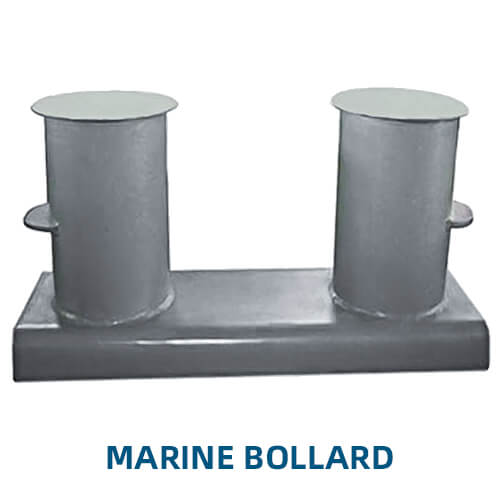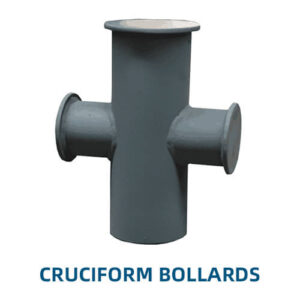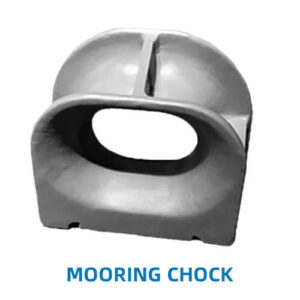Key Features of Marine Bollards:
- Design and Construction:
- Material: Typically made from robust materials such as cast iron, steel, or stainless steel. These materials are chosen for their strength, durability, and resistance to marine conditions.
- Shape: Commonly cylindrical, with a rounded top to facilitate the easy wrapping of mooring lines. The design often includes a base plate or mounting structure for secure attachment to the dock or pier.
- Size: Available in various sizes and load capacities to accommodate different types of vessels and mooring requirements. Larger bollards are used for bigger ships or high-load applications.
- Types:
- Single-Pole Bollards: Feature a single vertical post, often used in smaller docking applications or where space is limited.
- Double-Pole Bollards: Have two vertical posts and are used to provide additional strength and support, especially in high-load scenarios.
- Specialized Bollards: Include designs such as spring-loaded bollards, which absorb shock and reduce stress on mooring lines, or rotating bollards that allow for flexible line management.
- Applications:
- Dock and Pier Mooring: Used to secure vessels to docks and piers during loading, unloading, or when stationary. Bollards provide a fixed point for mooring lines, ensuring the vessel remains in place.
- Ship-to-Ship Mooring: Employed in ship-to-ship transfer operations to secure lines between two vessels, allowing for safe and stable transfer of cargo or personnel.
- Harbors and Ports: Installed in harbors, ports, and marinas to accommodate a wide range of vessels, from small boats to large commercial ships.
- Performance and Benefits:
- Strength and Durability: Marine bollards are designed to withstand substantial forces and environmental conditions, including heavy loads, corrosion, and exposure to saltwater.
- Stability: Provides a stable and reliable point for securing mooring lines, helping to prevent vessel movement and ensuring safety during mooring operations.
- Versatility: Available in various designs and sizes to meet the specific needs of different maritime applications.
- Maintenance and Care:
- Inspection: Regular inspection is crucial to check for signs of wear, corrosion, or structural damage. Inspect the bollard and its mounting for any signs of deterioration.
- Cleaning: Clean the bollard to remove debris, marine growth, or contaminants that could affect its performance or appearance. Corrosion-resistant coatings may be applied to extend the lifespan.
- Repairs: Address any damage or issues promptly to ensure the bollard remains functional and safe for use. This may involve welding, repainting, or replacing damaged parts.
- Safety Considerations:
- Load Capacity: Ensure that the bollard is rated for the specific load requirements of the mooring operation. Overloading can cause damage or failure.
- Installation: Proper installation is essential to ensure the bollard is securely anchored and able to withstand the forces applied during mooring.
- Usage: Educate personnel on the correct use of bollards and mooring lines to avoid accidents and ensure safe operations.
Advantages of Marine Bollards:
- Reliability: Provides a dependable and fixed point for securing vessels, ensuring stability and safety during berthing and mooring.
- Durability: Built to withstand harsh marine environments and high loads, making them suitable for long-term use in ports, docks, and other maritime facilities.
- Ease of Use: Simple to use and maintain, with minimal moving parts and straightforward functionality.
Considerations for Marine Bollards:
- Selection: Choose the appropriate type, size, and material of bollard based on the specific needs of the maritime facility and the types of vessels being accommodated.
- Corrosion Protection: Ensure bollards are coated or treated to resist corrosion and extend their lifespan in marine environments.
- Compliance: Follow relevant industry standards and regulations for bollard design, installation, and maintenance to ensure safety and performance.
Marine bollards are essential components in maritime operations, providing a reliable and strong point for securing mooring lines. Their durability and stability make them critical for the safe and effective mooring of vessels in various marine and port environments.







